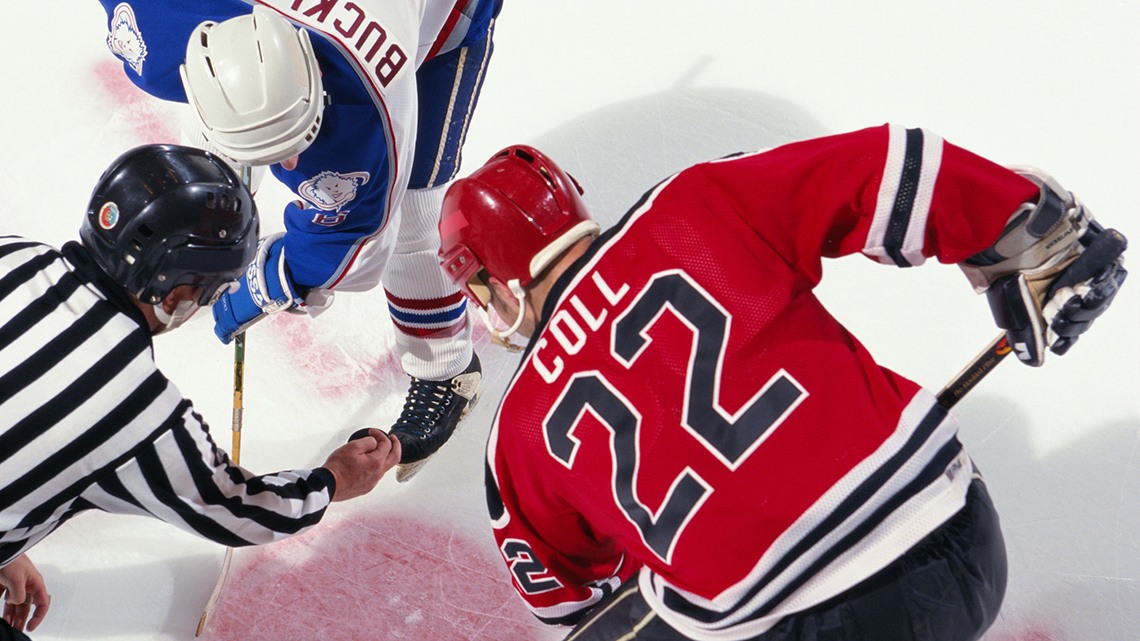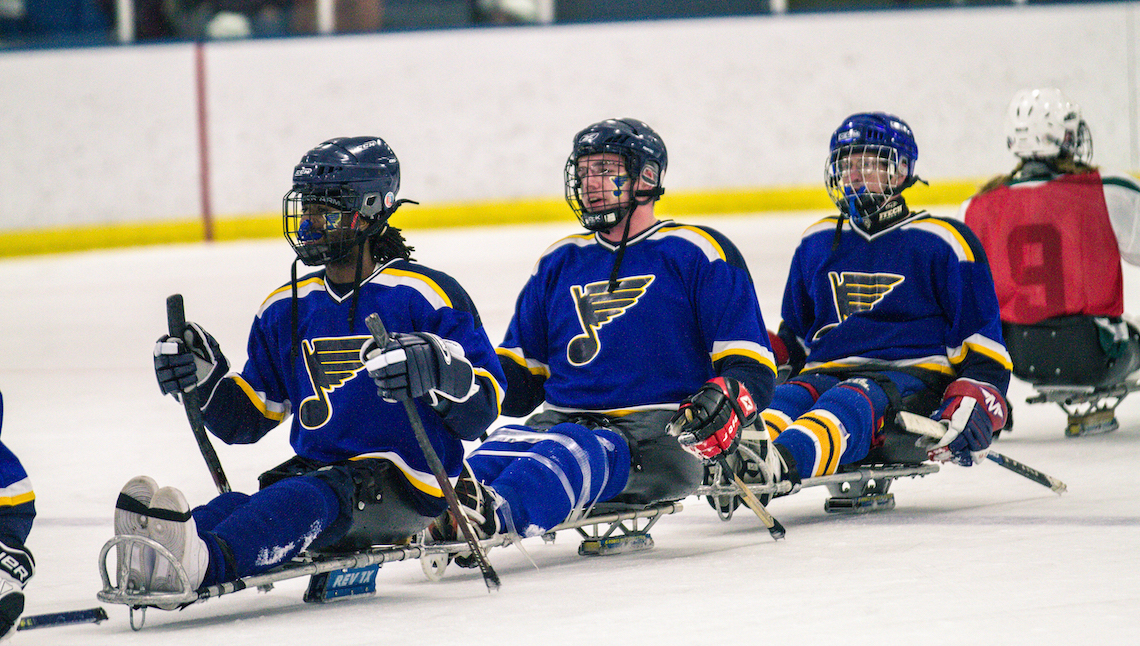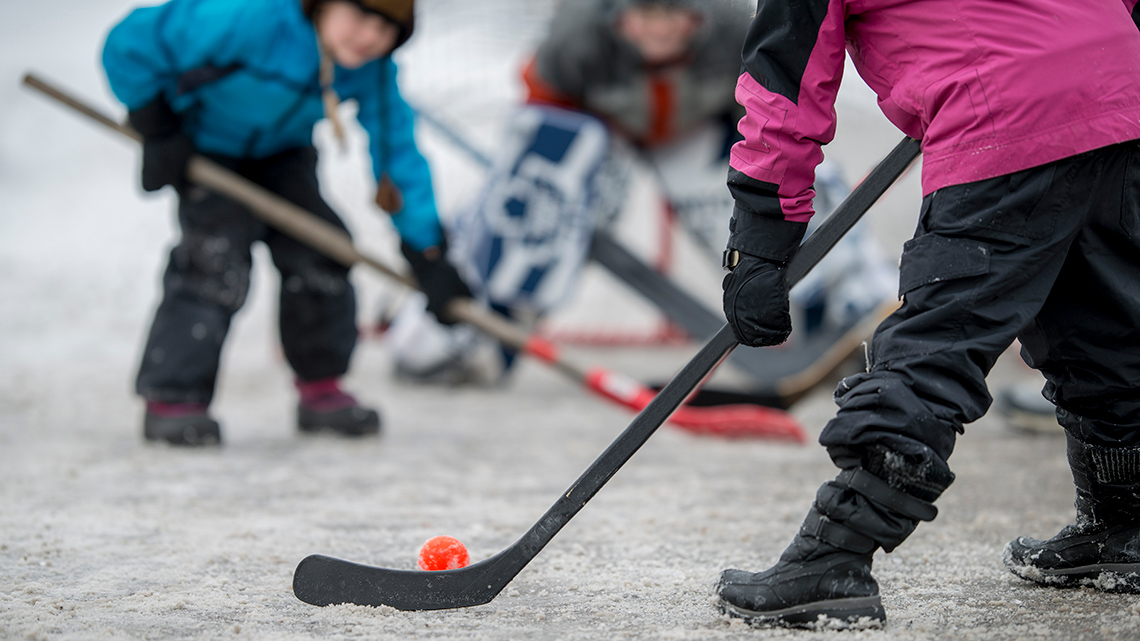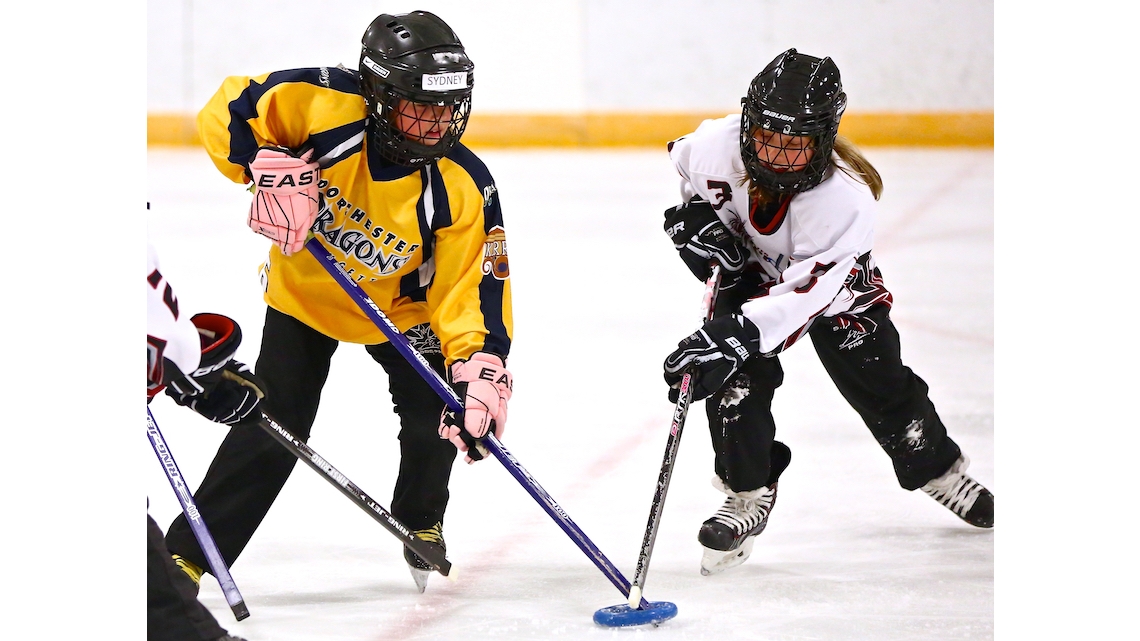Minds On
Think fast!

Using coins for a reaction challenge
In this learning activity, you will be developing skills in evading and dodging within hockey or soccer.
Evading and dodging
Evading is when you are physically avoiding or escaping from another player in a game. Evasion relies on an awareness of your opponents as well as your environment.
Dodging is often a quick change in direction to avoid or escape either from another player or from a piece of sports equipment. Dodges can involve a false move to indicate you were going to move in one direction, followed by a swift move to an opposite direction in order to mislead an opponent.
Before you begin, let’s try one or more of the reaction challenges.
Press the following tabs to access the reaction challenges.

The ruler drop challenge 1
You will need a ruler or metre stick for this challenge. You can also cut out cardboard into the shape of one.
The ruler drop challenge is most effective when done with a partner or you can also use your other hand to drop the ruler. Your partner will hold one end of the ruler vertically and you will put their thumb and index hovering just under the end of the other side of the ruler. Your partner will drop the ruler and you need to catch it with your hand as fast as you can.
Record the distance between the bottom of the ruler and where your hand landed when you caught the ruler. Do this ten times and compare the distances.
To change up the difficulty you may try to:
- do it with eyes closed
- have different noises or sounds either to distract or cue the drop of the ruler
- have your partner grip your shoulder to signal that the ruler is going to be dropped
How might the previous modifications affect your performance in this challenge?

The ruler drop challenge 2
You will need a meter stick or cut out cardboard into the shape of one.
In this challenge you will be finding how fast you can catch a ruler with your foot. Sit down on a chair facing a wall with your foot elevated perpendicular to the wall (90 degrees). Like in the first challenge you or a partner will hold the meter stick, so it hovers around the tip of the foot. Hover it against the wall. Your partner will then drop the metre stick and you need to trap it as fast as you can. Record the distance between the bottom of the metre stick and where your foot landed when you caught the ruler. Do this ten times and compare the distances.
To change up the difficulty you may try to:
- do it with eyes closed
- have different noises or sounds either to distract or cue the drop of the ruler
- have your partner grip your shoulder to signal that the ruler is going to be dropped
How might these modifications to the challenge affect your performance in this challenge?

The cobra coin snatch challenge
You will need three coins for this challenge.
Place your hand out with the coins placed on the back of your hand and arm in a line with each coin an equal distance from one another. Toss them in the air by motioning your arm upwards and try to catch them with your palm. Start with one coin and work your way up to more coins.
- How many coins can you catch consistently?
Reflecting on reaction challenges
After completing one or more of the challenges, reflect on the following questions:
- As you repeated the challenges did your performance improve? Why or why not?
- How could the challenges help you with your ability to evade or dodge an opponent in hockey or soccer?
Press ‘Answer’ to access a possible response to how the reaction challenges can help you evade or dodge.
The reaction challenges allow you to develop better reaction time.
Being able to react quickly to your surroundings is important when you are in a hockey or soccer game. You have to be aware of where your opponents and teammates are at all times in relation to the ball or puck when evading and dodging.
Action
Dodging and evading

Dodging and evasion sports
In both hockey and soccer, it is important to learn how to maintain control and possession of your puck/ball while avoiding your opponents. Being able to dodge and evade opponents is key.
Safety
Before you begin, consider these safety precautions:
Warm Up
Warm up
Let’s do a warm up before we get into our main activities! Warm ups will help you better perform a movement/activity while also greatly reducing your chance of injury.
Depending on what activities you are performing, choose one of the following warm ups, or you may do a combination of them.
Press the following tabs to access the warm ups.

- Jogging: Let’s start off with a relaxed jog for 5 minutes. You can jog in one place 20or back and forth in your space.
- Jumping jacks: Now do 10 jumping jacks! To perform a jumping jack, position your body straight up with hands to your sides. Then jump and spread legs apart and bring arms above the head. After that, jump back into starting position.
- Toe touch: Time to touch our toes! Have your body straight up. Then lean and bend forward and try your best to touch your toes. Hold the position for 10-20 seconds, return to straight upward position and repeat 10 times.
- Sit-up: Now do 10 sit-ups! To set-up a sit-up, lay on your back and bend your knees to form a ‘V’ shape with your legs. Bend your upper body towards your knees to perform the sit-up.
- Mountain climber: Finally, do the mountain climber for 60 seconds. To perform the mountain climber set yourself up in the push up position, then bring each knee forward as if you were climbing.

- Neck Tilts and Rotations: Slowly tilt your head side to side 10 times and then slowly and carefully rotate your neck 10 times in each direction.
- Arm Circles: Straighten your body and put your arms straight out to the sides. Then start forming circles in one direction, start with small circles and work your way up to large circles. Do this 10 times and then repeat with the opposite direction.
- Chest Expansions: Straighten your body and put your arms out straight to the sides with palms of hand facing forward. Bring your hands together in a clapping motion slowly, then return to the starting position. Do this 10 times.
- Wrist Circles: Clasp your wrists together and start to circle your wrists in one direction. Do this 10 times and then repeat with the opposite direction.
- Shoulder Rolls: Put your arms to the side keeping your posture straight. Rotate your shoulders forward to make a circle. Do this 10 times and then repeat with the opposite direction.

- High Knee Jog: Standing straight with shoulder-width apart perform a jog but raise your knees to about waist level. Do this for two minutes.
- Side-to-Side Hops: Standing straight with hands to side and feet hip-width apart hop side to side quickly. Do this for two minutes.
- Lunges: Stand straight with feet hip-width apart and arms grabbing the side of your hips. Take a step forward and bend your knees so that you form two 90-degree angles with your legs with one leg forward and one leg behind. Hold the position for 20-30 seconds then switch legs and repeat. Do this three times.
- Squat Side Kick: Go into a squat position so that your feet are shoulder-width apart and your hips are back. Then gradually get up and shift your weight towards one leg so that you can lift your other leg out to the side in a slow kick motion. Then return to the squatting position. Do this 10 times for each leg.
- Lateral Leg Swing: Stand upright, holding onto a wall with one hand for support and the other hand placed on the side of your hip. Swing one leg in front carefully across your body from side to side for 10 times. Then repeat with other leg.
Hockey
There are many forms of hockey and depending on what equipment you have available in your learning space you may choose to adapt the skills and drills.
Explore the following carousel to learn more about diverse variations of hockey.
Check out the following skills for evading and dodging in hockey.
Stickhandling
Stickhandling in hockey is a skill where you are retaining an object. The technique of retaining an object is commonly known as dribbling in other sports. Retaining is a skill where you keep possession of an object such as a puck or a ball while staying still or while moving. Retaining an object is one of the most fundamental skills.
Dodging and evading are skills you can use to help avoid opponents while you retain a puck or a ball.
Explore the following video “Ice Hockey Player Scores a Goal” to learn more about how a hockey player stickhandles a puck towards the goal while dodging another player.
Press the following tab to learn how to stickhandle a hockey puck or ball.
- Maintain a low centre of gravity by bending your knees and upper body forwards. Have your feet about shoulder width apart. The puck/ball is just in front of you.
- Hold the stick with one hand gripping near the top of the stick and the other hand around the middle of the stick.
- When making contact with the ball aim to have it near the middle of the blade of the hockey stick.
- Adjust the force depending on how wide you would like to dribble the puck/ball. Less force allows for greater control.
- Move your hockey stick back and forth over the ball/puck as you dribble and move.
Deke or spin away
A deke is a technique where you fake out your opponents. A deke is a form of evasion to convince your opponent to move in the opposite direction so you can move past them. With a deke, you are changing up both your speed and direction.
One form of a deke is known as a spin away. A spin away is a move where you quickly move in a circle instead of moving forward where your opponent expects you to go.
Explore the following video for a demonstration of a spin away.
How to perform a spin away
- Start by pretending you are going to move to one side with your puck. Move your skates and your puck towards one side as you approach your opponent.
- Instead of moving forward, swiftly turn your skates and your hockey stick in a circle. Use your skates to lightly brake to help you turn in a tight circle.
- As you are braking, move your puck to the inside of your hockey stick to steer it in a circle along with your body.
- Now that you have completed your circle, swiftly move away from your opponent before they realize you have turned instead of moving forward!
Soccer
Check out the following skills for evading and dodging in soccer.
Basic dribbling
Like in hockey, dribbling is an important skill to have when evading and dodging in soccer. This requires the ability to switch direction and maintain control of the soccer ball with your foot.
Explore the following video “Dribbling a Ball to Goal” to access a demonstration of a soccer player dribbling a ball towards the goal while dodging another player.
Press the following tabs to learn how to perform soccer evasion techniques including a basic dribble, a drag push, and a stepover.
- Be aware of the ball and your surroundings. Focus on where you want to go with the ball.
- Adjust your body to keep a weighted balance by bending your knees, having arms out and toes on the ready.
- You can move the ball either with the inside or the outside of your foot.
- Have the ball within two metres of you to sustain control of it.
A drag push is a skill that you use when you are moving with the ball and you come face to face with an opponent. In a drag push you are trying to fake out an opponent, so that they think you are going in the opposite direction you intend to go.
A drag push can be started with either the inside or the outside of your foot. For example, you can push the ball inwards with the inside of your foot to indicate you are moving in one direction. Then, quickly move your foot over the ball and use the outer edge of your foot to push the ball outwards and in the opposite direction.
Explore the following video for a demonstration of the drag push.
The stepover or scissors is another skill that attempts to fake out opponents to make them think you are moving in a different direction. Basically, you are moving your non-kicking foot above and around the ball to make the opponent think you are kicking it with that foot and then quickly move the ball with your kicking foot in the opposite direction. You can fake out the opponent even more by faking a kick several times by moving your feet above and around the ball before finally having one foot kick it.
Check out the following video for a demonstration of the stepover/scissors move.
Try It
Drill the skills
Now that you have explored some skills for dodging and evading in hockey and soccer, let’s practise them by trying the following drills that could be used for either sport.
Remember to perform your safety checks before participating in the drills!
Press the following tabs to access the equipment and drills to practise your dodging and evading.
The equipment you would need if you decided on hockey are:
- a hockey puck, ball, or a ringette ring. You could make a ringette ring out of a disposable paper/plastic/styrofoam plate by cutting a circle in the centre.
- a hockey stick. You may also use other types of sticks such as a metre stick, broom stick, or dustpan.
- pylons, bottles, and/or cans
The equipment you would need if you decide on soccer are:
- a ball or round object that is safe to kick
- pylons, bottles, and/or cans
Cone weaving drills are great for improving your ability to control the ball/puck with speed and accuracy. In these drills, you are trying to travel around the cones as fast as possible while dribbling the ball/puck.
The following is a diagram of three different variations of how you may want to set-up the cones/bottles/cans. You may also design your own cone weaving drill pattern.

Cone weaving drills
Cone weaving drills are a kind of practice where you move a ball/puck in a pattern around cones. The wide pattern has several cones placed far apart in a long line. Move the ball/puck from one side of a cone to the opposite side of the next cone. The narrow pattern has several cones placed close together in a short line. Move the ball/puck from one side of a cone to the opposite side of the next cone. The zig zag pattern has the cones placed far apart in two lines. Move the ball/puck from one side of a cone to the opposite side of the next cone.
Try to utilize the skills you learn as you weave through the cones. To challenge yourself, you can time how long it takes to go through all the cones.
In this drill, you will move towards another person/cone that will act as an opponent and then quickly change direction to go around them, so that you can dodge them and continue straight into the direction you originally were going.

Changing direction drill
The changing direction drill is a way to practice how to evade an opponent. Start by moving with the ball/puck in a straight line towards your opponent. As you get close to your opponent swiftly change your direction to move slightly around them. Make sure you keep control of the ball/puck! Once you have moved around your opponent, adjust your direction to continue moving in a straight line.
In this drill, the opponent is stationary, but for an added challenge, if you are able to work with another person, they may move around. You can also set up more than one cone or have more than one person act as opponents to create a circuit practice where you are trying to dodge multiple opponents.
Cool Down
Cool down
Now it’s time for a cool down! It’s important to allow your body to gradually return to a resting state after intense physical activity.
Remember to perform your safety check before you begin.
Depending on what activities you are performing, choose one of the following cool downs, or you may do a combination of them.
Press the following tabs to access the cool downs.

- Jogging: Begin with a jog and transition to a walk. Do this for 2-5 minutes.
- Wide Toe Touch: Now do wide toe touches for 60 seconds. To perform a wide toe touch, position your body in the shape of a star, then bend forward and reach with one arm to touch the opposite foot. The other arm which is on the same side as the foot is pointed upwards. Hold this position for 10-15 seconds, then return to the starting position and repeat on the opposite side.
- Quad Stretch: Stand up straight and shift your weight to one leg. Then lift your other leg backwards towards your butt and grab it with the arm on the same side. Hold it for 20-30 seconds and repeat with the other leg. Do this 5 times for each leg.
- Child’s Pose: Do the child pose for 30 seconds. To perform the child pose, get down on your knees and bend your body forwards stretching your arms out. Your forehead should be resting on the floor.
- Abdominal Stretch: Now, do an abdominal stretch for 30 seconds. To perform the abdominal stretch, lie face down with legs straight up and place your arms in a push up position. Push upwards and slowly lift your torso holding the position.

- Shoulder Stretch: Bring one arm across your chest bend your other arm to help support it into position. Hold the position for 30 seconds and then do the opposite side. Repeat three times.
- Triceps Stretch: Bend one arm up and behind towards your shoulder blade. Use the other arm to help support it into position. Hold the position for 30 seconds and then do the opposite side. Repeat three times.
- Overhead Stretch: With your body straight interlock your fingers and bring your arms above your head. Have your palms facing away from you. Hold the position for 60 seconds.
- Torso Stretch: With your body straight fold one arm behind your back and use the other arm to help support it into position. Then bend your torso towards one side. Hold the position for 30 seconds and then do the opposite side. Repeat three times.
- Chest-Cross Arm Swing: With your body straight put your hands horizontally straight out to the sides and then swing your arms to make an ‘X’ shape back and forth for 60 seconds.

- Flutter Kick: Lie on your back with your hands to the side. Lift your legs and perform a kicking motion, alternating the legs back and forth. Do this for one minute.
- Side-Lying Leg Lifts: Lie on your side with one arm supporting your head and one arm bend in front supporting your body in position pushing against the ground. Lift your leg slowly and gradually return it back. Do this five times and then switch to the other leg.
- Single Leg Hug: You can do this lying on your back or standing straight up. With your arms hug your thigh to bring one knee towards your chest. Hold the position for 20-30 seconds then gradually release and switch sides. Repeat three times.
- Butterfly Stretch: Sitting on the floor bring both feet together so they are touching. Use your arms to safely move your knees towards the floor. Hold the position for 20-30 seconds and then release gradually. Repeat three times.
- Hip Flexor Stretch: Kneel on one of your knees and bend your other leg in front of your body at approximately a 90-degree angle. Shift your weight forward until you feel a stretch. Hold the position for 20-30 seconds and switch sides. Repeat three times.
Consolidation
Demonstration

Dodging opponents
Now let’s demonstrate our skills in dodging and evading. You will explain some tips and tricks for dodging and evading in either hockey or soccer. Choose one of the following or a method of your choice to demonstrate your skills:
- video/audio clips
- slideshow
- poster
- brochure
- comic strip
- webpage
Use the following checklist to help ensure that you have covered all that you need in your demonstration.
Demonstration success criteria
Reflection
As you read the following descriptions, select the one that best describes your current understanding of the learning in this activity. Press the corresponding button once you have made your choice.
I feel…
Now, expand on your ideas by recording your thoughts using a voice recorder, speech-to-text, or writing tool.
When you review your notes on this learning activity later, reflect on whether you would select a different description based on your further review of the material in this learning activity.
Press ‘Discover More’ to extend your skills.
Discover MoreYou can practise your dodging and evading skills with games such as tag and dodge ball. The following are three games you can play with a group of people.
Freeze tag
Choose one person to be “It.” When a person is tagged, they must stay frozen in their position until they are tagged by another player that is not it. When everyone is frozen the game ends.
Octopus
Choose one person to the octopus. All other players are fish and line up at one end of the playing field (ocean). The octopus shouts out “octopus” and the fish try to run across the playing field without getting touched. If a fish gets touched, they become a seaweed. Seaweed stay in place and they help the octopus by touching other fish to turn them into seaweed as well. The game ends when the last fish is tagged.
Doctor dodgeball
You will need a few balls or even socks rolled into balls for this game. These will be placed in the centre of the playing field at the beginning of the game. The playing field is divided so that teams are on either side of the area. Break your group in teams of two and select one to two players (depending on your group size) on each team to be doctors.
Doctors are allowed to tag players who are out to bring them back into play. Players that have been hit by the ball or had their ball caught by an opponent must sit down as they are out of the game. The game ends once one team has all their players out of the game.



